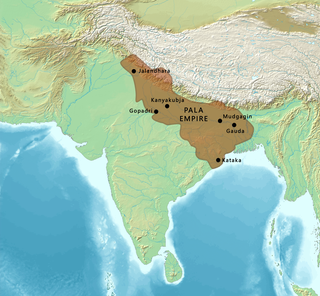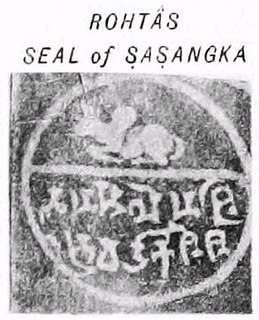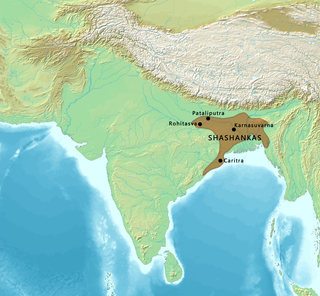
The Pala Empire was an imperial power during the post-classical period in the Indian subcontinent, which originated in the region of Bengal. It is named after its ruling dynasty, whose rulers bore names ending with the suffix Pala. The empire was founded with the election of Gopala as the emperor of Gauda in 750 CE. The Pala stronghold was located in western Bengal and eastern Bihar, which included the major cities of Gauda, Vikrampura, Pataliputra, Monghyr, Somapura, Ramvati (Varendra), Tamralipta and Jaggadala.

The Sena dynasty was a Hindu dynasty during the early medieval period on the Indian subcontinent, that ruled from Bengal through the 11th and 12th centuries. The empire at its peak covered much of the north-eastern region of the Indian subcontinent. The rulers of the Sena Dynasty traced their origin to the south Indian region of Karnataka.

Shashanka was the first independent king of a unified polity in the Bengal region, called the Gauda Kingdom and is a major figure in Bengali history. He reigned in the 7th century, some historians place his rule between circa 600 CE and 636/7 CE, whereas other sources place his reign between 590 and 625 CE.

The Gahadavala dynasty, also Gahadavalas of Khanauj, were among the rulers of Indian subcontinent, that ruled parts of the present-day Indian states of Uttar Pradesh and Bihar, during 11th and 12th centuries. Their capital was located at Varanasi in the Gangetic plains, and for a brief period, they also controlled Kanyakubja.

The Mlechchha dynasty ruled Kamarupa from their capital at Harruppesvar in present-day Tezpur, Assam, after the fall of the Varman dynasty. According to historical records, there were twenty one rulers in this dynasty, but the line is obscure and names of some intervening rulers are not known.Like all other Kamarupa dynasties which extended till central Assam,a semi-mythical lineage from Narakasura was constructed to accord legitimacy to their rule. The Mlechchha dynasty in Kamarupa was followed by the Pala kings. The dynasty is unrelated to the previous Varman dynasty.

The Pala dynasty of Kamarupa kingdom ruled from 900 CE. Like the Pala Empire of Bengal, the first ruler in this dynasty was elected, which probably explains the name of this dynasty "Pala". But unlike the Palas of Bengal, who were Buddhists, the Palas of Kamarupa were Hindus. The Hindu orthodoxy drew their lineage from the earlier Varman dynasty and thus ultimately from Narakasura i.e. Bhauma dynasty. The dynasty is unrelated to the previous Varman and Mlecchna dynasty.

Bikrampur was a pargana situated 19 kilometres (12 mi) south of Dhaka, the modern capital city of Bangladesh. In the present day, it is known as Munshiganj District of Bangladesh. It is a historic region in Bengal and was a part of the Bhawal Estate.
Ramapala was the successor to the Pala king Shurapala II in the Bengal region of the Indian subcontinent, and fifteenth ruler of the Pala line.
Madanapala was the successor to the Pala king Gopala IV in the Bengal region of the Indian subcontinent, and eighteenth and final ruler of Pala lineage reigning for 18 years. He was succeeded by Govindapala, whose lineage of that name is questionable.
Lakshmana Sena, also called Lakshman Sen in modern indian languages, was the ruler from the Sena dynasty of the Bengal region on the Indian subcontinent. His rule lasted for 28 years; and extended to much of the eastern regions of the Indian subcontinent, notably Bengal and Bihar regions. His reign ended with the invasion of Muhammad bin Bakhtiyar Khilji.
Govindapala is believed to be the successor of Madanapala the last ruler of the Pala dynasty in the Bengal region of the Indian subcontinent. However, the relationship between them has not been discovered yet.

Gauda, was a territory located in Bengal in ancient and medieval times, as part of the Gauda Kingdom. 11th Century Persian scholar Al-Biruni mentioned it as Purva-Desa or Eastern Country.
Dandabhukti was an ancient and medieval region located amidst the two rivers, Dwarakeswar and Subarnarekha. It was situated within the Rarh region, a part of the Gupta Empire. It spanned an area that now comprises Bankura, Hooghly, Paschim Medinipur, and Purba Medinipur districts in the Indian state of West Bengal.

Lower Assam is a region situated in Western Brahmaputra Valley encompassing undivided Kamrup and Goalpara regions. Soon after the formal creation of the British districts in 1833, Lower Assam denoted one of the five initial districts that were created west of the Dhansiri river, which, along with the six paraganas, became a single district of Kamrup in 1836. It was home to the kingdom of Kamarupa, ruled by Varman's and Pala's from their capital's Pragjyotishpura (Guwahati) and Durjaya. Today Guwahati is the largest city of North-East India while Dispur, the capital of Assam, is within the town.

Ratna Pala was the son of Brahma Pala in Pala Dynasty (900–1100) of Kamarupa Kingdom. His queen's name was Durlabha. He was succeeded by Indra Pala.

Indra Pala was ruler of Pala Dynasty (900–1100) of Kamarupa Kingdom.

Jaya Pala (1075-1100) was a ruler during the Pala Dynasty (900–1100) of Kamarupa Kingdom.

Kamarupa – Late to end period was a period of Kamarupa kingdom from founding of Pala Dynasty by Brahma Pala to last ruler of dynasty Jaya Pala.

The Gauḍa Kingdom or Shashankas, was a classic kingdom during the Classical period on the Indian subcontinent, which originated in the region of Bengal in 4th century CE or possibly earlier.

The Varman Dynasty of Bengal was a Hindu dynasty which originated in the Bengal region of the Indian subcontinent. The Varmans took control of Eastern Bengal after replacing the Chandra Dynasty. They established their capital at Bikrampur in present-day Munshiganj District of Bangladesh.











